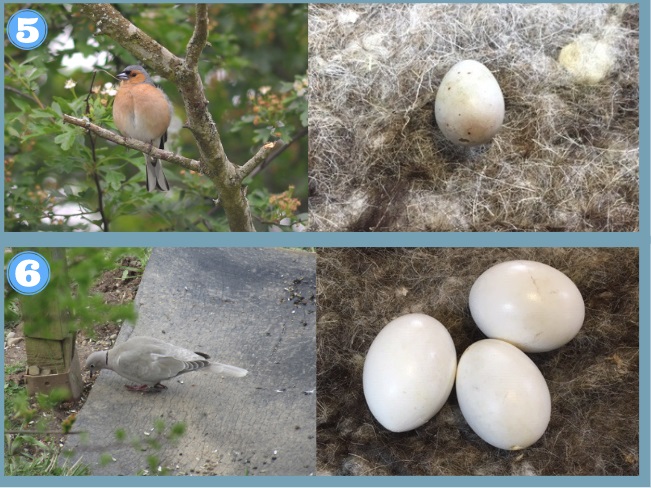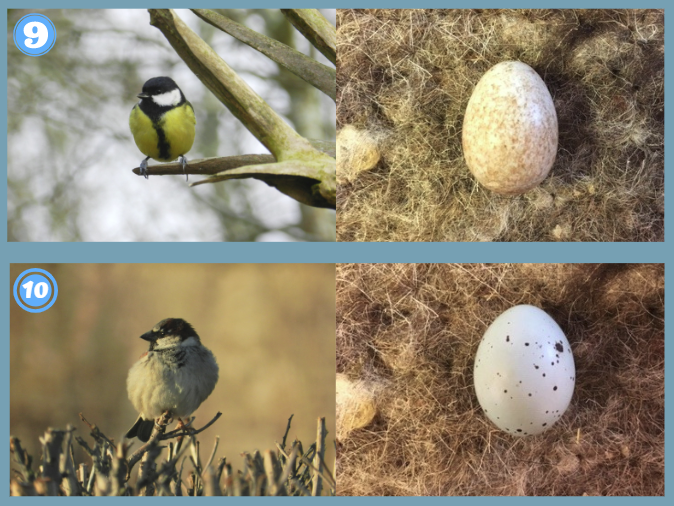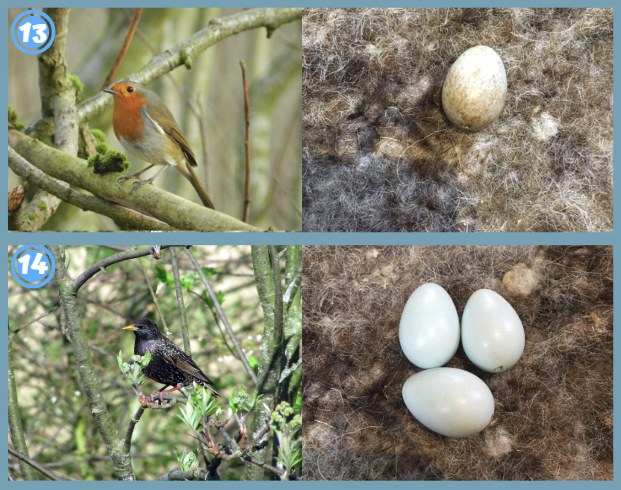Identifying Birds’ Eggs
Have you encountered fragments of bird egg shells in your garden, in the woods or when you’re out and about? They can be interesting finds, but which birds do they come from?
This illustrated guide with our top tips will help you identify some of the more common shells you’re likely to find.
If you find egg remnants on the ground, they’re likely to have been carried away after hatching by parent birds and discarded. They tend to drop them well away from their nests so they don’t attract predators.
Please remember it is important not to disturb breeding birds and it’s against the law to take their eggs.
If you have knowledge of the whereabouts of any birds’ nests, particularly rarer breeds, then please be careful with that information. Do not openly discuss or post any information online that could be used by egg thieves, even when the breeding season is over.
Egg Facts
- A clutch is a group of eggs that are laid at the same time. This can vary widely between species.
- A brood is a set of young birds hatched at the same time by the same parents. As you’ll see from this blog, some birds can have several broods each year, while others only have a single brood.
Different species have different eggs and with so many colours, sizes and shapes it can be difficult for us to tell whose is whose. In general, bird egg shells are made of calcium carbonate and so the default colour is white. But other pigments can cause eggs to take on different colours and patterns.
- Birds that build their nests in trees and shrubs (like dunnock and blackbird) generally have blue or greenish eggs, either spotted or unspotted.
- The eggs of hole-nesting birds are generally white or pale blue so that the parent birds can easily locate them and avoid breaking them. Egg camouflage is less important because the egg is usually well hidden within the nest.
- Birds that lay their eggs in the open and on the ground rely on their eggs being very well camouflaged so usually produce brown or speckled eggs.
- Blue and green coloured egg shells help protect developing embryos from the potentially damaging effect of UV sunlight.
Did you know, that common cuckoos display egg mimicry whereby their eggs are the same colour as those of the host nest bird?
-
-
-
- Blackbird
A common garden and woodland bird with arguably the most beautiful song of all birds. The blackbird can have two or even three broods a year and breeds from early spring until mid-summer.
Description: blue-green eggs with brown speckles.
Egg size: 2.9 x 2.1 cm
Clutch size: 3-5 - Blue Tit
The blue, yellow and white blue tit is one of the most recognisable garden birds. Eggs are usually laid in April or May into a nest built of mainly moss, grass and feathers.
Description: light-cream with light brown speckles.
Egg size: 1.6 x 1.2 cm
Clutch size: 8-10
Blackbird and Blue Tit Eggs
(© Blackbird & Nest-Andy Wakelin / Blue Tit-SWT / Blue Tit Eggs – Wikimedia Commons) - Bullfinch
The male birds are unmistakable with their bright pink-red breast and cheeks. Bullfinches lay their eggs during April-May, in a delicate nest made from twigs, fine roots and moss.
Description: light green-blue with purple markings.
Egg size: 2 x 1.5 cm
Clutch size: 4-5 - Carrion Crow
Carrion crows are large, all-black birds that prefer to lead a solitary life. They usually build their nests in the forks of trees and lay eggs between April-May.
Description: pale blue-green with brown and grey markings.
Egg size: 4.3 x 3cm
Clutch size: 4-7
Bullfinch and Carrion Crow Eggs
(© Bullfinch – Richard Blackburn / Bullfinch Eggs – Wikimedia Commons / Carrion Crow – SWT / Carrion Crow Eggs – Wikimedia Commons) - Chaffinch
Chaffinches are easily distinguished by their white wing-bar and their eggs are usually laid in spring from around April.Description: off white eggs with brown-red splotches.
Egg size: 1.9 x 1.5 cm
Clutch size: 4-5 - Collared Dove
Now one of the UK’s commonest birds, collared doves can have three or more broods, and can lay eggs from early in the year to the end of autumn.Description: white-cream with no markings.
Egg size: 3.1 x 2.4 cm
Clutch size: 2
- Blackbird

Chaffinch and Collared Dove
(© Chaffinch – Nick Townell / Chaffinch Eggs –SWT / Collared Dove – SWT / Collared Dove Eggs – SWT)-
- Dunnock
Also known as the hedge sparrow, these greyish birds will lay their eggs in a nest constructed of grass, leaves and roots. They can have several broods a year.
Description: light blue with no markings.
Egg size: 1.9 x 1.5 cm
Clutch size: 4-5 - Goldfinch
A brightly coloured finch with a red face and yellow wing patch. Goldfinch nests are neat and compact with a deep cup to prevent the eggs from being lost in high winds. They lay their eggs from late April and may have up to 2 to 3 broods.
Description: whitish with reddish-brown speckles.
Egg size: 1.7 x 1.3 cm
Clutch size: 4-6
- Dunnock

(© Dunnock – SWT / Dunnock Eggs – Wikimedia Commons / Goldfinch – Andy Wakelin / Goldfinch Eggs – SWT) -
- Great Tit
This colourful bird is the UK’s largest tit. It makes a nest of moss and feathers, before laying its eggs in early spring.
Description: white eggs with light brown-red speckles.
Egg size: 1.8 x 1.4 cm
Clutch size: 7-9 - House Sparrow
These small brown birds are often heard chirping away. Pairs will build nests of grass and straw before laying their eggs, usually in May. They can have several broods each year.
Description: white-light grey eggs with grey-brown markings.
Egg size: 2.2 x 1.6 cm
Clutch size: 4-5
- Great Tit

(© Great Tit – Harry Bikerstaff / Great Tit Eggs – Wikimedia Commons / House Sparrow – Harry Bikerstaff / House Sparrow Eggs – SWT) - Jackdaw
Jackdaws are small black crows with a silvery sheen. They usually lay eggs during April-May, and have one brood a year.
Description: white/pale blue with grey and brown markings.
Egg size: 3.6 x 2.6 cm
Clutch size: 4-5
-
-
12. Pheasant
Pheasants, with their rich golden-brown plumage and long tails, were introduced to the UK as game birds. They are now widespread, nesting on the ground and lay their eggs during April-June.
Description: olive-brown with no markings.
Egg size: 4.5 x 3.6 cm
Clutch size: 7-15

(© Jackdaw – SWT / Jackdaw Eggs – Wikimedia Commons / Pheasant – Andy Wakelin / Pheasant Eggs – Wikimedia Commons)
13. Robin
A familiar and well-loved garden bird with its cheerful red breast. Robins will start to lay their eggs around April and can have two broods a year.
Description: white-cream eggs with light brown speckles.
Egg size: 2 x 1.5 cm
Clutch size: 4-5
14. Starling
Noisy, glossy, shimmering birds, starlings nest in holes in trees and buildings and lay their eggs in mid-April.
Description: pale blue with no markings.
Egg size: 2.1 x 3cm
Clutch size: 4-6

(© Robin – Harry Bikerstaff / Robin Eggs – SWT / Starling – Andy Wakelin / Starling Eggs – SWT)
This is not, by any means, an exhaustive list of birds’ eggs you may come across and just a selection of the species currently nesting in and around Montrose Basin. If you’d like to learn more about birds and birds’ eggs pop into our Visitor Centre, where we run Guided Bird Walks and children’s educational activities, or visit the Scottish Wildlife Trust website: www.scottishwildlifetrust.org.uk
Rachel Mackay-Austin
Seasonal Visitor Centre Assistant / Teacher Naturalist
(Director RiverWood Ecology Ltd.)
Help protect Scotland’s wildlife
Our work to save Scotland’s wildlife is made possible thanks to the generosity of our members and supporters.
Join today from just £4 a month to help protect the species you love.
Preface
Have you encountered fragments of bird egg shells in your garden, in the woods or when you’re out and about? They can be interesting finds, but which birds do they …
